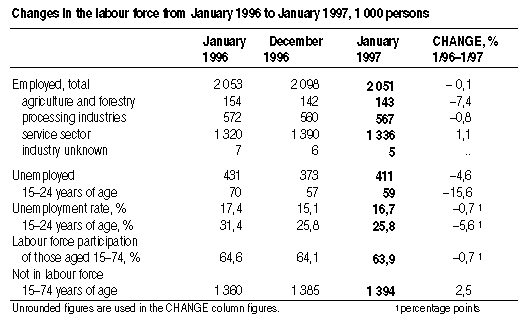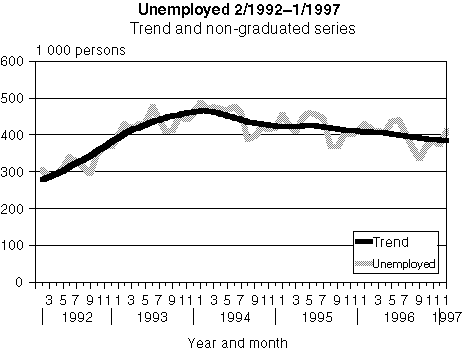3 March 1997
Further decline in unemployment
In the year to January vacancies increased in the service sector, in wholesale and retail trade in particular, but were down in agriculture and forestry as well as in the processing industries. All in all the number of employed amounted to 2 051 000 in January, being almost the same as the year before. This information can be gathered from the revised the Labour Force Survey of Statistics Finland.
The Labour Force Survey of Statistics Finland has been revised to better correspond to the concepts and definitions used by the European Union and the International Labour Organisation (ILO). At the same time the contents of the survey were broadened and made more accurate. The revised LFS provides new information on atypical work, underemployment, disguised unemployment, jobseeking and the duration of unemployment.
The impact of the revision on the employment and unemployment levels is small. According to preliminary surveys the number of employed persons will be slightly higher and that of the unemployed somewhat lower than the those produced using the old method.

The number of jobs for women increased slightly over the year while those for men fell somewhat. There was a slight improvement in the seasonally adjusted employment from December to January.
Unemployment stood at 411 000 in January, which is 20 000 less than a year earlier. Men accounted for 221 000 of the unemployed and women for 190 000. The seasonally adjusted unemployment figure fell slightly from December to January.
The unemployment rate fell by 0.7 percentage points to 16.7 per cent over the year. The unemployment rate of men was 17.3 per cent and that of women 16.1 per cent. There were 59 000 unemployed young people in January, which is roughly 10 000 less than the year before.
The unemployment rate fell in all branches of industry, the highest rate being that in construction, at 32.6 per cent.

The employment figures vary more or less regularly according to the
time of year.
This seasonal variation, similar from year to year, has been
eliminated from the curve.
60 per cent of the new vacancies are part-time or fixed-term jobs
According to the revised classification 10 per cent, i.e. over 180 000 of the employees, had part-time jobs in January, whereas 15 per cent were employed on a fixed-term basis.
Over 60 per cent of all new employment contracts of less than 12 months' duration, were atypical ones, either part-time or fixed-term contracts. Fixed-term job contracts accounted for 55 per cent of the total. Employment contracts lasting less than 12 months amounted to over 300 000 in number.
Comparability back on track in January 1998
Owing to the revision of the Labour Force Survey comparisons made in 1997 on the year before will be less reliable than normally. An estimate was made on the impact that the revision had on the figures for January and December 1996 and the figures presented here were adjusted accordingly.
The revision was based on the results of the parallel survey conducted between March-December 1996. The sample in the survey was, however, fairly small and did not cover the whole year, so the revisions are crude. The comparability of the survey will reach the customary level in January 1998, when data for the revised survey will have been collected for a whole year.
Since the Labour Force Survey is a sample survey, random variation has to be taken into account when assessing the changes. The confidence interval of the January unemployment rate is ± 0.6 percentage points and that of the number of unemployed ± 14 700 persons.
The data for the Labour Force Survey of Statistics Finland were collected by interviewing some 12 000 Finnish residents of working age. The data are from between January 13 and 19. The Labour Force Survey is a panel survey where over a period of 18 months each person is included five times in the sample.
The Labour Force Survey produces data both on employment and unemployment. It is based on the international recommendations of the International Labour Organisation (ILO) and the survey is comparable to statistics produced by other countries.
453 000 unemployed job seekers in January
The Ministry of Labour also publishes statistics on unemployment. The data are on unemployed job seekers on the last working day of each month. Owing to differences in methods and definitions, the unemployment figures issued by Statistics Finland and the Ministry of Labour are not fully comparable. The trend in the changes is generally in the same direction, with the figures of the Ministry of Labour being higher by some thousands. At the end of January 453 000 unemployed persons were registered in the job applicants register of the Ministry of Labour.
Source: Labour Force Survey, January 1997. Statistics
Finland
Inquiries: Mr Tapio Oksanen, tel. +358 9 1734 3228, Mr Hannu
Siitonen,
tel. +358 9 1734 3225, Ms Salme Kiiski, tel. +358 9 1734 3230
and
Mr Timo Koskimäki, tel. +358 9 1734 3517.
